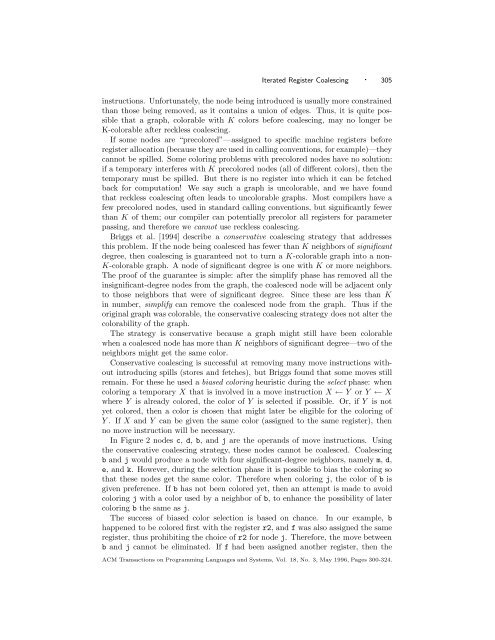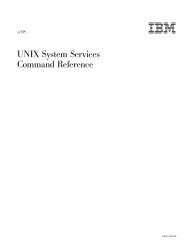Iterated Register Coalescing - School of Computer Science
Iterated Register Coalescing - School of Computer Science
Iterated Register Coalescing - School of Computer Science
You also want an ePaper? Increase the reach of your titles
YUMPU automatically turns print PDFs into web optimized ePapers that Google loves.
<strong>Iterated</strong> <strong>Register</strong> <strong>Coalescing</strong> · 305instructions. Unfortunately, the node being introduced is usually more constrainedthan those being removed, as it contains a union <strong>of</strong> edges. Thus, it is quite possiblethat a graph, colorable with K colors before coalescing, may no longer beK-colorable after reckless coalescing.If some nodes are “precolored”—assigned to specific machine registers beforeregister allocation (because they are used in calling conventions, for example)—theycannot be spilled. Some coloring problems with precolored nodes have no solution:if a temporary interferes with K precolored nodes (all <strong>of</strong> different colors), then thetemporary must be spilled. But there is no register into which it can be fetchedback for computation! We say such a graph is uncolorable, and we have foundthat reckless coalescing <strong>of</strong>ten leads to uncolorable graphs. Most compilers have afew precolored nodes, used in standard calling conventions, but significantly fewerthan K <strong>of</strong> them; our compiler can potentially precolor all registers for parameterpassing, and therefore we cannot use reckless coalescing.Briggs et al. [1994] describe a conservative coalescing strategy that addressesthis problem. If the node being coalesced has fewer than K neighbors <strong>of</strong> significantdegree, then coalescing is guaranteed not to turn a K-colorable graph into a non-K-colorable graph. A node <strong>of</strong> significant degree is one with K or more neighbors.The pro<strong>of</strong> <strong>of</strong> the guarantee is simple: after the simplify phase has removed all theinsignificant-degree nodes from the graph, the coalesced node will be adjacent onlyto those neighbors that were <strong>of</strong> significant degree. Since these are less than Kin number, simplify can remove the coalesced node from the graph. Thus if theoriginal graph was colorable, the conservative coalescing strategy does not alter thecolorability <strong>of</strong> the graph.The strategy is conservative because a graph might still have been colorablewhen a coalesced node has more than K neighbors <strong>of</strong> significant degree—two <strong>of</strong> theneighbors might get the same color.Conservative coalescing is successful at removing many move instructions withoutintroducing spills (stores and fetches), but Briggs found that some moves stillremain. For these he used a biased coloring heuristic during the select phase: whencoloring a temporary X that is involved in a move instruction X ← Y or Y ← Xwhere Y is already colored, the color <strong>of</strong> Y is selected if possible. Or, if Y is notyet colored, then a color is chosen that might later be eligible for the coloring <strong>of</strong>Y . If X and Y can be given the same color (assigned to the same register), thenno move instruction will be necessary.In Figure 2 nodes c, d, b, andj are the operands <strong>of</strong> move instructions. Usingthe conservative coalescing strategy, these nodes cannot be coalesced. <strong>Coalescing</strong>b and j would produce a node with four significant-degree neighbors, namely m, d,e, andk. However, during the selection phase it is possible to bias the coloring sothat these nodes get the same color. Therefore when coloring j, thecolor<strong>of</strong>b isgiven preference. If b has not been colored yet, then an attempt is made to avoidcoloring j with a color used by a neighbor <strong>of</strong> b, to enhance the possibility <strong>of</strong> latercoloring b thesameasj.The success <strong>of</strong> biased color selection is based on chance. In our example, bhappened to be colored first with the register r2, andf was also assigned the sameregister, thus prohibiting the choice <strong>of</strong> r2 for node j. Therefore, the move betweenb and j cannot be eliminated. If f had been assigned another register, then theACM Transactions on Programming Languages and Systems, Vol. 18, No. 3, May 1996, Pages 300-324.









